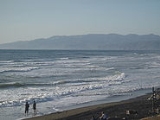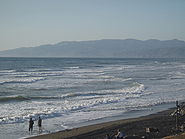
National Ocean Service
Encyclopedia
The National Ocean Service (NOS), an office within the U.S. Department of Commerce National Oceanic and Atmospheric Administration
, is responsible for preserving and enhancing the nation’s coastal resources and ecosystems along 95000 miles (152,887.3 km) of shoreline bordering 3500000 square miles (9,064,958.4 km²) of coastal, Great Lakes
, and ocean waters. Its mission is to "provide science-based solutions through collaborative partnerships to address evolving economic, environmental, and social pressures on our oceans and coasts." NOS works closely with many partner agencies to ensure that ocean
and coastal areas are safe, healthy, and productive. National Ocean Service scientists, natural resource managers, and specialists ensure safe and efficient marine transportation, promote innovative solutions to protect coastal communities, and conserve marine and coastal places.
, and provides tools and information to protect and restore coastal and marine resources.
 NOS is a scientific and technical organization of 1,700 scientists, natural resource managers, and specialists in many different fields. NOS delivers a dynamic range of nationwide coastal and Great Lakes scientific, technical, and resource management services in support of safe, healthy, and productive oceans and coasts. NOS develops partnerships to integrate expertise and efforts across all levels of government and with other interests to protect, maintain, and sustain the viability of coastal communities, economies and ecosystems.
NOS is a scientific and technical organization of 1,700 scientists, natural resource managers, and specialists in many different fields. NOS delivers a dynamic range of nationwide coastal and Great Lakes scientific, technical, and resource management services in support of safe, healthy, and productive oceans and coasts. NOS develops partnerships to integrate expertise and efforts across all levels of government and with other interests to protect, maintain, and sustain the viability of coastal communities, economies and ecosystems.
, flooding, and harmful algal blooms. NOS scientists develop tools and information to help coastal managers and communities restore damaged natural resources
, deal with the impacts of climate change
, and evaluate contaminants and monitor cleanup efforts.
NOS is a steward and manager of marine resources including marine sanctuaries, estuarine reserves, marine protected areas, and coral reefs. NOS scientists support coastal zone management and are marine oil spill
first responders. Researchers focus on issues relating to marine debris
, coastal and estuarine land conservation, conservation of coral reefs, and natural resource assessment and restoration.
to help mariners navigate safely. NOS scientists monitor and predict tides and currents, coordinate more than 1,000 global positioning reference stations, conduct hazardous obstruction surveys, and provide techniques to establish accurate elevations.
Program Offices:
Programs:
Staff Offices:
National Oceanic and Atmospheric Administration
The National Oceanic and Atmospheric Administration , pronounced , like "noah", is a scientific agency within the United States Department of Commerce focused on the conditions of the oceans and the atmosphere...
, is responsible for preserving and enhancing the nation’s coastal resources and ecosystems along 95000 miles (152,887.3 km) of shoreline bordering 3500000 square miles (9,064,958.4 km²) of coastal, Great Lakes
Great Lakes
The Great Lakes are a collection of freshwater lakes located in northeastern North America, on the Canada – United States border. Consisting of Lakes Superior, Michigan, Huron, Erie, and Ontario, they form the largest group of freshwater lakes on Earth by total surface, coming in second by volume...
, and ocean waters. Its mission is to "provide science-based solutions through collaborative partnerships to address evolving economic, environmental, and social pressures on our oceans and coasts." NOS works closely with many partner agencies to ensure that ocean
Ocean
An ocean is a major body of saline water, and a principal component of the hydrosphere. Approximately 71% of the Earth's surface is covered by ocean, a continuous body of water that is customarily divided into several principal oceans and smaller seas.More than half of this area is over 3,000...
and coastal areas are safe, healthy, and productive. National Ocean Service scientists, natural resource managers, and specialists ensure safe and efficient marine transportation, promote innovative solutions to protect coastal communities, and conserve marine and coastal places.
Organization
As one of five NOAA Line Offices, NOAA's National Ocean Service (NOS) observes, studies, and manages the nation's coastal and marine resources. NOS measures and predicts coastal and ocean phenomena, protects large areas of the oceans, works to ensure safe navigationNavigation
Navigation is the process of monitoring and controlling the movement of a craft or vehicle from one place to another. It is also the term of art used for the specialized knowledge used by navigators to perform navigation tasks...
, and provides tools and information to protect and restore coastal and marine resources.

Protecting coastal communities
NOS prepares coastal communities for change including the effects of natural hazards such as hurricanes, tsunamis, erosionErosion
Erosion is when materials are removed from the surface and changed into something else. It only works by hydraulic actions and transport of solids in the natural environment, and leads to the deposition of these materials elsewhere...
, flooding, and harmful algal blooms. NOS scientists develop tools and information to help coastal managers and communities restore damaged natural resources
Natural Resources
Natural Resources is a soul album released by Motown girl group Martha Reeves and the Vandellas in 1970 on the Gordy label. The album is significant for the Vietnam War ballad "I Should Be Proud" and the slow jam, "Love Guess Who"...
, deal with the impacts of climate change
Climate change
Climate change is a significant and lasting change in the statistical distribution of weather patterns over periods ranging from decades to millions of years. It may be a change in average weather conditions or the distribution of events around that average...
, and evaluate contaminants and monitor cleanup efforts.
NOS is a steward and manager of marine resources including marine sanctuaries, estuarine reserves, marine protected areas, and coral reefs. NOS scientists support coastal zone management and are marine oil spill
Oil spill
An oil spill is the release of a liquid petroleum hydrocarbon into the environment, especially marine areas, due to human activity, and is a form of pollution. The term is mostly used to describe marine oil spills, where oil is released into the ocean or coastal waters...
first responders. Researchers focus on issues relating to marine debris
Marine debris
Marine debris, also known as marine litter, is human created waste that has deliberately or accidentally become afloat in a lake, sea, ocean or waterway. Oceanic debris tends to accumulate at the centre of gyres and on coastlines, frequently washing aground, when it is known as beach litter or...
, coastal and estuarine land conservation, conservation of coral reefs, and natural resource assessment and restoration.
Ocean and human health
NOS provides early-warning systems and forecasts for threats to human health and coastal economies. NOS collects integrated ocean and coastal observations. NOS monitors both natural and human impacts on ecosystems and provides tools and training to help coastal managers make good decisions about managing coastal and ocean resources.Marine navigation
NOS scientists perform many activities to support safe and efficient marine navigation. NOS provides updated nautical charts, hydrographic surveys, and aerial photographyAerial photography
Aerial photography is the taking of photographs of the ground from an elevated position. The term usually refers to images in which the camera is not supported by a ground-based structure. Cameras may be hand held or mounted, and photographs may be taken by a photographer, triggered remotely or...
to help mariners navigate safely. NOS scientists monitor and predict tides and currents, coordinate more than 1,000 global positioning reference stations, conduct hazardous obstruction surveys, and provide techniques to establish accurate elevations.
NOS capabilities
NOS consists of eight program offices and two staff offices that manage and preserve the nation's ocean and coasts. Specifically, NOS:- Provides products, services, and data, such as nautical charts, a framework for consistent geographic reference, and tidal and water-level monitoring.
- Manages 13 national marine sanctuaries and one national monument and provides funding to coastal states to manage 27 national estuarine research reserves.
- Participates in immediate response to hazardous spill events, damage assessment, and restoration activities.
- Supports states in protecting resources and guiding economic development in coastal areas. NOS also supports training for state coastal managers participating in the program.
- Assesses, monitors, and predicts the consequences of natural and human-induced environmental hazards such as hurricanes, erosion, and sea-level rise.
NOS organization
NOS is organized into program offices, programs, and staff offices:Program Offices:
- Center for Operational Oceanographic Products and Services (CO-OPS)
- NOAA Coastal Services Center (CSC)
- National Centers for Coastal Ocean Science (NCCOS)
- Office of Coast Survey (OCS)
- Office of National Geodetic Survey (NGS)
- Office of National Marine Sanctuaries (ONMS)
- Office of Ocean and Coastal Resource Management (OCRM)
- Office of Response and Restoration (OR&R)
Programs:
- NOAA Integrated Ocean Observing System (IOOS) Program
Staff Offices:
- International Program Office (IPO)
- Management and Budget Office (MBO)
See also
- National Estuarine Research ReserveNational Estuarine Research ReserveThe National Estuarine Research Reserve System is a program of the United States government. The program establishes federal-state partnerships under the Coastal Zone Management Act to create a system of estuarine research reserves representative of the various regions and estuarine types in the...
External links
- National Ocean Service (NOS)
- Center for Operational Oceanographic Products and Services (CO-OPS)
- NOAA Coastal Services Center (CSC)
- National Centers for Coastal Ocean Science (NCCOS)
- Office of Coast Survey (OCS)
- Office of National Geodetic Survey (NGS)
- Office of National Marine Sanctuaries (ONMS)
- Office of Ocean and Coastal Resource Management (OCRM)
- Office of Response and Restoration (OR&R)
- NOAA Integrated Ocean Observing System (IOOS) Program
- International Program Office (IPO)
- Management and Budget Office (MBO)
- National Oceanic and Atmospheric Administration (NOAA)

